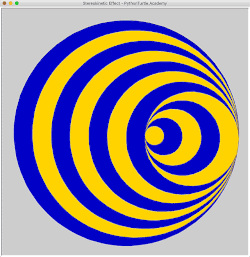Biology:Stereokinetic stimulus
From HandWiki
Stereokinetic stimulus, stereokinetic depth, stereokinetic illusion is an illusion of depth induced by moving two-dimensional stimuli. [1] A stereokinetic stimuli generates 3D perception based on 2D rotational motion.[2] A stereokinetic effect is created when flat displays are rotated in the frontal plane and are perceived as having three-dimensional structure. [3] [4]
History
Ernst Mach first reported a depth effect produced by motion in the frontoparallel plane in 1886.[1] Marcel Duchamp first experimented with stereokinetic depth in 1935.[5]
References
- ↑ 1.0 1.1 Vezzani, Stefano; Kramer, Peter; Bressan, Paola (2015-08-20). "Stereokinetic effect, kinetic depth effect, and structure from motion" (in en). doi:10.1093/oxfordhb/9780199686858.013.053. https://www.gestaltrevision.be/storage/files/1/oxford_handbook/Vezzani&Kramer&Bressan-Stereokinetic_effect_kinetic_depth_effect_and_structure_from_motion.pdf.
- ↑ Rokers, Bas; Yuille, Alan L.; Liu, Zili (2006). "The Perceived Motion of a Stereokinetic Stimulus" (in en). Vision Research. https://www.cs.jhu.edu/~ayuille/pubs/ucla/A200_brokers_VISRES2006.pdf.
- ↑ Wilson, John A; Robinson, James O (2000). "Form and Movement in Stereokinetic Cycloids: Motion Lost and Found". Perception 29 (7): 843–851. doi:10.1068/p2929. PMID 11064805.
- ↑ Caudek, Corrado; Proffitt, Dennis R. (1993). "Depth Perception in Motion Parallax and Stereokinesis". Journal of Experimental Psychology: Human Perception and Performance 19. http://wexler.free.fr/library/files/caudek%20(1993)%20depth%20perception%20in%20motion%20parallax%20and%20stereokinesis.pdf.
- ↑ Bach, Michael. "Stereokinetic Effect (SKE)" (in en). https://michaelbach.de/ot/mot-ske/.
 |


